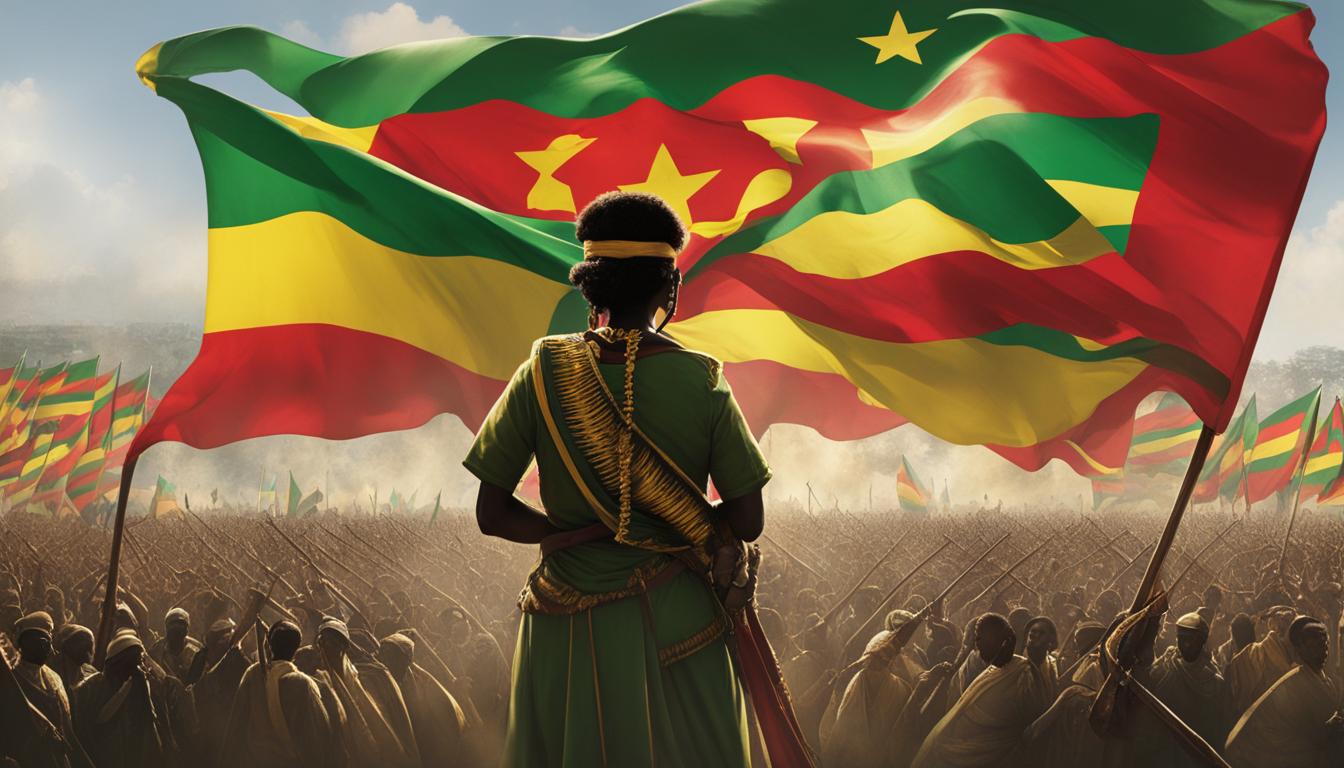Every year, Ethiopians come together to celebrate Derg Downfall Day, a significant milestone in their history that marks the end of the oppressive Derg regime in 1991. This turning point in Ethiopian history represents the resilience of the Ethiopian people and their desire for democratic reforms, fundamental rights, and national unity. As the nation gathers in commemoration of this crucial event, let us take a journey through the tumultuous times that led to the Derg’s downfall and the hope that it engendered for Ethiopia’s prosperous future.
Key Takeaways
- Derg Downfall Day is an important milestone in Ethiopian history, marking the end of the Derg regime in 1991.
- This turning point symbolizes Ethiopia’s shift from oppressive rule to a new national direction focused on democratic reforms and fundamental rights.
- Ethiopians commemorate the day to honor the sacrifices made during the civil war that led to the democratization process and the resilience of the Ethiopian people.
- The event highlights the impact of the Derg regime on Ethiopian society, culture, and politics, and offers a chance for reflection and healing.
- Modern Ethiopia continues to build on the foundation of unity, diversity, and democracy established after the Derg regime’s fall, working to create a prosperous and inclusive nation.
The Prelude to Derg Downfall Day: Ethiopia’s Historical Struggle
The story of the Derg regime collapse is deeply rooted in Ethiopia’s rich, historical tapestry. Spanning from the ancient civilization of D’mt, through the powerful kingdoms of Aksum, and extending to modern struggles, Ethiopia’s historical chapters set the stage for the eventual overthrow of the oppressive Derg regime.
As the 20th century dawned, Ethiopia faced turbulent times. From foreign invasions to internal reform movements, the nation struggled to navigate the complexities of political change. These modern challenges would prove instrumental in shaping the eventual downfall of the Derg regime and the birth of a new chapter in Ethiopian history.
“Ethiopia has an extensive history that led up to the fall of the Derg regime, and the complexity of this past plays a crucial role in understanding the nation’s path to freedom.”
Throughout Ethiopia’s history, a strong yearning for change inspired its people to rise against forces of oppression. In this quest for freedom, they would endure immense struggles, but ultimately the result would be the fulfillment of their collective aspirations. The Derg downfall symbolizes this triumph, marking an end to a tumultuous era and paving the way for a brighter future.
The Derg regime’s collapse was neither a standalone event nor an isolated incident. Rather, it was the culminating chapter of a long and rich history of Ethiopian struggle and perseverance.
- The early civilization of D’mt
- The powerful kingdoms of Aksum
- Modern struggles against foreign invasions and internal reform movements
As we commemorate the historical context of Derg downfall, it is essential to remember that this defining moment in Ethiopian history was the result of centuries of strife and resilience. It stands as an enduring testament to the indomitable spirit of the Ethiopian people and their unwavering pursuit of freedom.
Understanding the Derg: Origins and Ideologies
The Derg, officially known as the Provisional Military Government of Socialist Ethiopia, emerged as a powerful force during the turbulent period of the Ethiopian Civil War. Established in 1974, the Derg initially positioned itself as a regime that would rectify the wrongs of the previous leadership, but soon developed a reputation for its Marxist-Leninist ideologies, oppressive tactics, and the enforcement of socialist policies that left a profound mark on the socio-political fabric of the nation.
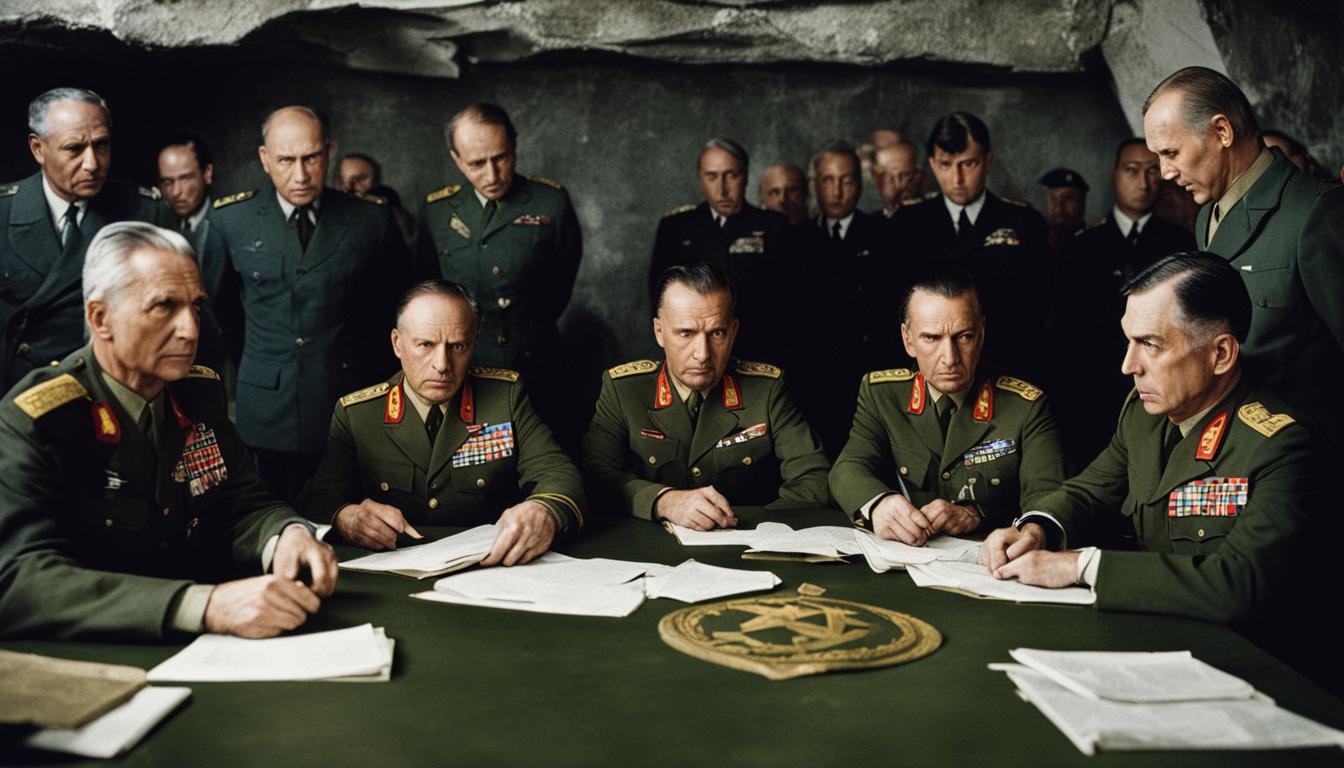
At its core, the Derg’s primary objective was to overthrow the flawed monarchy that had long ruled Ethiopia and introduce a socialist government that promised to bring about equality, social justice, and progress. However, as the Derg’s power increased, its approach became increasingly dogmatic, with the regime enforcing strict policies and employing severe methods to achieve its goals.
“We are here to rectify the past leadership but soon became known for its Marxist-Leninist leanings, oppressive tactics, and the enforcement of socialist policies that deeply impacted the socio-political fabric of Ethiopia.”
- The Derg’s Origins:
- Ethiopian Civil War:
- Derg Ideologies:
The Derg originated from a Coordinating Committee of the Armed Forces, Police, and Territorial Army, formed by a group of disgruntled military officers who were dissatisfied with the imperial government’s inability to address the country’s economic, political, and social issues. As they consolidated power, the Derg began executing prominent officials of the monarchy and eventually deposed Emperor Haile Selassie, laying the groundwork for their socialist regime.
The Ethiopian Civil War, which lasted from 1974 to 1991, served as a catalyst for the rise and eventual downfall of the Derg. Numerous factions, including the Eritrean People’s Liberation Front (EPLF) and the Tigrayan People’s Liberation Front (TPLF), fought against the Derg’s authoritarian rule, ultimately leading to its collapse and the establishment of a new political system in Ethiopia.
The Derg’s ideologies were rooted in Marxism-Leninism, a revolutionary socialist political philosophy that emphasizes centralized control of the means of production, strict adherence to socialist principles, and a commitment to the establishment of a communist society. This ideological shift resulted in significant changes to Ethiopia’s political, economic, and social landscape.
| Key Aspect | Explanation |
|---|---|
| Origins | The Derg was formed by a group of military officers dissatisfied with the imperial government and its handling of the nation’s issues. |
| Role in Ethiopian Civil War | The Derg’s oppressive rule contributed to the Ethiopian Civil War, ultimately leading to its downfall and the establishment of a new political system in Ethiopia. |
| Ideologies | At the heart of the Derg’s ideologies is an adherence to Marxism-Leninism, which sought to transform Ethiopia’s socio-political system into a communist society. |
In conclusion, the Derg’s origins, role in the Ethiopian Civil War, and Marxist-Leninist ideologies profoundly shaped the socio-political context of Ethiopia during its reign. Although initially seen as a promising force for change, the oppressive tactics and dogmatic approach employed by the Derg would ultimately lead to its downfall and pave the way for a new chapter in Ethiopia’s history.
The Derg Downfall Event: The Turning Point in Ethiopian Politics
The downfall of the Derg regime marked a major transformation in Ethiopian politics, ending a period of authoritarian rule and opening the door for the nation to pursue a new political path towards democracy and national reconstruction. This turning point was characterized by the climactic battle that led to Ethiopia overthrowing the Derg, the significance of the event for new beginnings in the country, and the profound emotional impact on Ethiopians who had long struggled for freedom.
Ethiopia Overthrows Derg: The Climactic Battle
The fall of the Derg was the result of a sustained resistance movement and a series of battles that culminated in the collapse of the regime. The climactic moment arrived in 1991 when rebel forces entered the capital city, Addis Ababa, leading to the surrender of the Derg leadership and a major realignment of the nation’s governance structure.
From the outset, the Derg’s oppression met with fierce opposition from Ethiopian citizens demanding greater political autonomy and representation. The resistance movement, an amalgamation of various factions and political organizations, waged a relentless campaign against the harsh authoritarian rule. Their efforts ultimately prevailed, heralding the dawn of a post-Derg era in Ethiopian politics.
Significance of Derg Downfall: New Beginnings for Ethiopia
The significance of the Derg Downfall lies in the hopeful inception of a new beginning for Ethiopia. It promised a break from the past’s restrictive policies and aimed at embarking on a path of reform and democratization that would craft a resilient, inclusive, and prosperous nation. The new beginnings initiated by the downfall of the Derg enabled Ethiopia to reassess its governance structure, moving away from concentrated power and towards greater decentralization and popular participation.
The Emotional Impact on Ethiopians
Witnessing the disintegration of the Derg regime had a profound emotional impact on Ethiopians. It was a moment of liberation, reflection, and intense emotion as the populace grappled with the memories of the hardship endured under the Derg’s rule and the anticipation of freedom, healing, and national rebuilding in the post-Derg era.
Ethiopians from all walks of life emerged from the Derg’s downfall with renewed hope and determination to craft a better future for their nation, driven by the shared aspiration to overcome the legacy of authoritarianism and foster a thriving, diverse, and inclusive society.
As Ethiopians collectively embarked on the journey of democratic transition and social reconciliation, the fall of the Derg continued to resonate as a potent symbol of Ethiopian freedom and the enduring spirit of resilience that defines the nation’s history.
Chronicles of Bravery: Heroes of the Derg Revolution Aftermath
Post-Derg Ethiopia is marked by stories of extraordinary bravery and sacrifice. The heroes of the revolution are venerated for their resolute spirit in the face of severe adversity, laying down their lives for the promise of a freer and fairer Ethiopia.
Stories of Sacrifice: Martyrs of the Movement
The martyrs of the movement against the Derg regime are commemorated for their ultimate sacrifice during the prolonged civil war. Their stories resonate through generations, inspiring current and future Ethiopians to value the freedoms and rights they fought for. These tales of heroism and selflessness continue to be an integral part of Ethiopia’s collective memory, serving as a constant reminder of the determination and solidarity that fueled the revolution.
“In valor, there is hope. In sacrifice, there is honor.”
It is through the valiant efforts of these Ethiopian martyrs that the country was able to withstand the Derg regime’s oppressive rule and ultimately emerge victorious in this struggle for liberation.
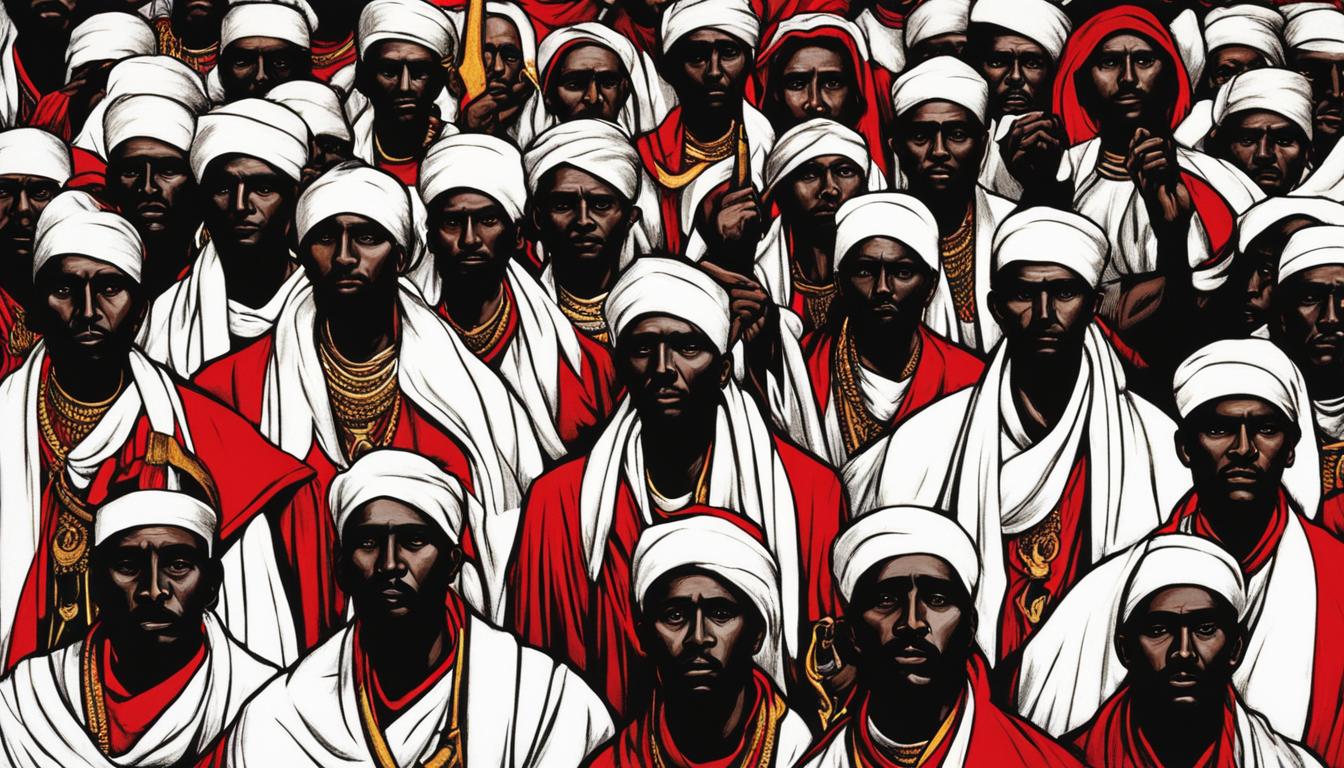
Women in the Fall of the Derg Regime
Women played a significant role in the fall of the Derg regime, both on the frontlines and behind the scenes. Their involvement ranged from participation in battles to providing essential support roles, breaking traditional gender stereotypes and paving the way for women’s empowerment in the socio-political realm.
| Role of Women | Impact |
|---|---|
| Combatants | Contributed to the defeat of the Derg regime and highlighted women’s bravery and competence in the struggle for freedom. |
| Logistics and Support | Provided critical support in areas such as communication, transportation, and medical care, proving indispensable for the success of the revolution. |
| Intel Gathering | Acted as spies and informants, utilizing their unique skills and resources to gather crucial information to aid the revolutionary forces. |
| Advocates for Change | Lobbied for socio-political change through public demonstrations, interviews, and cultural events, raising awareness and inspiring the population to resist the Derg regime. |
Their courage and dedication to the cause significantly contributed to the successful outcome of the civil movement, showcasing the pivotal role women can play in achieving social and political change.
In the wake of the Derg revolution aftermath, the nation has come to appreciate the bravery of their heroes, the stories of sacrifice from the Ethiopian martyrs, and the crucial roles women played in the struggle for a freer Ethiopia.
National Celebrations: Commemorating the Victory Over Derg
Each year on Derg Downfall Day, Ethiopia comes together to remember and celebrate the momentous victory over the oppressive Derg regime. A diverse range of national celebrations have been organized throughout the country, highlighting the unity and resilience of the Ethiopian people.
Patriotic speeches, delivered by government officials, historical figures, and influential members of society, emphasize the importance of remembering the sacrifices made by countless Ethiopians. These speeches shed light on the past while looking toward a brighter future, with the goal of fostering continued progress and unity in the nation.
“Derg Downfall Day reminds us of the courage, determination, and sacrifices of those who fought for our freedom. Together, as a nation, we honor their memories and ensure that their efforts were not in vain. Let us continue to work towards a more inclusive, prosperous, and democratic Ethiopia.”
Alongside these impassioned speeches, colorful parades featuring traditional music, dance, and performances showcase the rich cultural heritage of Ethiopia. These vibrant displays celebrate the nation’s history and the remarkable resilience of its people.
- Traditional music and dance performances
- Parades featuring national flags and banners
- Poetry and storytelling sessions
- Art exhibitions commemorating the struggle against the Derg
- Speeches from survivors and descendants of fallen heroes
The Derg Downfall Day celebrations serve as a testament to Ethiopia’s unwavering commitment to unity, progress, and upholding its democratic values. The festivities remind all Ethiopians of the collective strength and resilience that brought down the oppressive rule of the Derg, and they inspire hope for a brighter future in the nation.
Historical Context of Derg Downfall: Ethiopia’s Place in African History
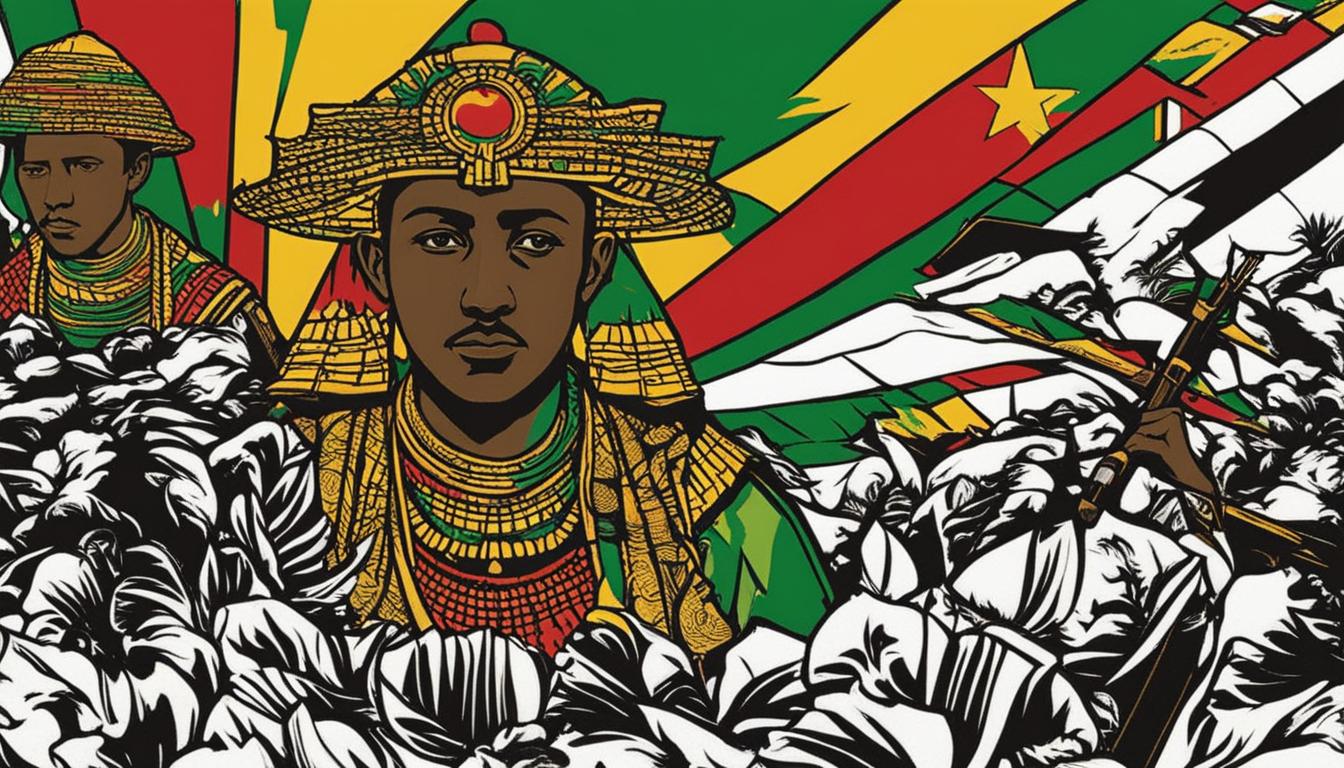
Ethiopia’s distinct position in the African historical narrative sets it apart due to its ancient origins and unique chronological path. The country’s storied history involves resisting colonization and addressing exceptional internal challenges, such as the rule of the Derg regime. The fall of the Derg regime strikes a chord with the broader Pan-African narrative of struggle, resilience, and the aspiration for self-determination.
“The Derg downfall serves as a symbol of the collective drive towards overcoming colonial and authoritarian legacies to achieve national sovereignty and self-governance.”
Comparative Struggles: Ethiopia within the Pan-African Narrative
In the wider African context, Ethiopia’s battle against the Derg regime bears similarities with the greater Pan-African movement for independence and self-determination. The following table showcases a comparison of Ethiopia’s struggle against the Derg regime and other African movements for liberation:
| Ethiopia (Derg Regime) | Other African Movements |
|---|---|
| Struggle against a repressive local regime | Fighting for freedom from colonial powers |
| Dismantling an oppressive socialist system | Systemic change from chiefly or monarchical rule to democracy |
| Aspiration for democracy and self-governance | Struggle for self-determination and national sovereignty |
| Emphasis on national unity in the face of adversity | Stress on the African identity and solidarity |
The historical context of the Derg Downfall deeply resonates with the Pan-African narrative, emphasizing the shared African experience of withstanding oppressive forces, be it colonial or indigenous. The successful dismantling of the Derg regime in Ethiopia proudly stands as an inspiration for many African movements, as it highlights the power of the human spirit to overcome adversity, and the unwavering pursuit of freedom, democracy, and self-determination.
Aftermath of Derg Downfall: Political and Social Changes
In the aftermath of the Derg downfall, Ethiopia underwent significant political changes and embarked on a journey towards social development. The transition to a federal system aimed to provide greater regional autonomy and democratic governance, replacing the stringent, centralized rule of the Derg regime. This shift in governance structure laid the foundation for various rebuilding initiatives that addressed crucial elements of social development, such as education, healthcare, and infrastructure.
The aftermath of the Derg downfall heralded a new era of hope, renewal, and transformation in Ethiopia.
Political Changes: A New Governance Structure
Ethiopia’s political landscape was reshaped by the establishment of a federal system and the introduction of democratic principles. Comprised of nine ethnically-based Regions and two chartered cities, the new governance structure sought to balance the needs for regional autonomy and national unity. The adoption of a new constitution in 1995 further reinforced the commitment to democratic principles and the protection of human rights, thereby reflecting a stark contrast to the Derg’s authoritarian rule.
Social Development: Rebuilding and Reform Initiatives
As Ethiopia left behind the dark shadows of the Derg era, several social development initiatives were launched to address the pressing needs of the nation. Among these key sectors were:
- Education: The reform of the education system focused on increasing accessibility, addressing the acute demand for skilled professionals and encouraging greater female participation in education.
- Healthcare: Prioritizing the improvement of healthcare services, various efforts were made to enhance the quality, coverage, and affordability of health facilities and make them accessible across urban and rural areas alike.
- Infrastructure: Recognizing the importance of a robust infrastructure in the nation’s growth, extensive projects were initiated to expand road networks, communication facilities, and access to essential utilities.
These social development initiatives, fueled by domestic and international support, have steadily transformed the lives of countless Ethiopians, setting the nation on a path towards progress and prosperity.
| Sector | Key Approaches |
|---|---|
| Education | Improving accessibility, enhancing quality, fostering gender equality |
| Healthcare | Expanding coverage, upgrading facilities, increasing affordability |
| Infrastructure | Building road networks, investing in communication facilities, ensuring access to utilities |
In conclusion, the aftermath of the Derg downfall marked the beginning of a new chapter in Ethiopian history, allowing for the blossoming of political and social changes that have been instrumental in reshaping the nation. The transition towards a federal system and the implementation of social development initiatives have laid the groundwork for a progressively better future for Ethiopia and its people.
Legacy of the Derg Downfall Day: Education and Remembrance
The legacy of Derg Downfall Day extends into the realms of education and remembrance, with initiatives to ensure that future generations are informed about the historical significance of the day and how it shaped the nation’s trajectory. These endeavours include curriculum development that embraces Ethiopian history, museums, and memorials that preserve the past and promote understanding of the nation’s journey towards peace and democracy.

Curriculum Development: Teaching Future Generations
Ethiopian education places a strong emphasis on teaching future generations about the nation’s complex history. This includes incorporating the period of the Derg regime’s rule into the curriculum, detailing its impact on Ethiopian society, the struggle that led to its downfall, and the values that emerged from this critical juncture.
- Emphasis on historical understanding: Curriculum development post-Derg focuses on teaching students about Ethiopia’s past, from its ancient origins to its modern challenges like the Derg regime. This holistic approach cultivates a deeper comprehension of the nation’s historical narrative.
- Promoting democratic values and national unity: By learning about the Derg era and its downfall, students absorb the values of democracy, resilience, and national unity that underlie Ethiopia’s present-day aspirations.
Museums and Memorials: Preserving History
Museums and memorials dedicated to the period of the Derg regime and its downfall play a crucial role in preserving Ethiopia’s historical narratives. These sites serve as places of education and reflection, honoring the sacrifices made by those who fought for freedom and justice.
Not only do these sites encourage visitors to remember the past, but they also inspire a commitment to uphold the values enshrined in the nation’s ongoing democratic journey.
| Museum/Memorial | Location | Significance |
|---|---|---|
| Red Terror Martyrs Memorial Museum | Addis Ababa | Dedicated to the victims of the Derg regime, the museum showcases personal accounts, relics, and artworks to offer visitors a deeper understanding of the human cost of this tumultuous period. |
| Yekatit 12 Square Monument | Addis Ababa | Commemorating the victims of the 1937 massacre during Italian occupation, this monument reminds Ethiopians of their history of resilience and the importance of national unity in overcoming adversity. |
By engaging with the educational and historical resources available in Ethiopia, citizens and guests alike can maintain an informed appreciation of the sacrifices made during the Derg era, ensuring the legacy of Derg Downfall Day continues to resonate through future generations.
Modern Ethiopia: Building on the Foundations Post-Derg
Modern Ethiopia has made significant strides in the years following the Derg regime’s downfall. Building on the foundations established in the post-Derg period, the country has been focusing on strengthening democratic institutions, promoting social justice, and fostering economic growth. These ongoing efforts include policies aimed at addressing historical grievances and creating an equitable society that appreciates its diverse cultural heritage.
Economic development remains a key priority in modern Ethiopia, with an emphasis on reducing poverty, expanding access to education and healthcare, and generating sustainable livelihoods for the country’s population.
Infrastructure projects, such as roads, bridges, and energy facilities, have been continuously implemented, directly contributing to the nation’s broader post-Derg development.
“Modern Ethiopia continues to build upon the foundations established in the post-Derg period, focusing on strengthening democratic institutions, promoting social justice, and fostering economic growth.”
For a closer look at the sectors contributing to the nation’s development, consider the following table outlining some of the key areas of focus:
| Sector | Post-Derg Developments |
|---|---|
| Education | Expansion of primary and secondary school availability, increasing emphasis on higher education, investments in teacher training programs, and adult education initiatives. |
| Healthcare | Implementation of comprehensive healthcare reforms, expansion of healthcare access, improvement in maternal and child health services, and investments in disease prevention measures. |
| Agriculture | Improvements in productivity, modernization of farming practices, emphasis on sustainable agriculture, and promotion of agricultural exports. |
| Infrastructure | Construction of new roads, bridges, and public transport systems; investments in water and sanitation infrastructure; enhancement of telecommunications network; and development of renewable energy projects. |
| Democratic Institutions | Strengthening the rule of law, establishment of independent institutions, emphasis on government transparency and accountability, and promotion of inclusive politics. |
Moreover, cultural revitalization has been embraced, as modern Ethiopia strives to safeguard the nation’s rich traditions and foster a sense of unity amidst diversity. Concerted efforts have been made to preserve the country’s distinct languages, arts, and customs, while simultaneously promoting contemporary expressions of Ethiopian culture.
In conclusion, modern Ethiopia’s ongoing journey towards national reconstruction reveals the resilience and determination of a nation that has survived and emerged stronger following a dark chapter in its history. Building on the foundations established in the post-Derg period, Ethiopia continues to strive for a brighter, more prosperous future that honors the sacrifices of its past and fulfills the potential of its diverse, vibrant population.
The Influence of Derg End on Subsequent African Revolutions
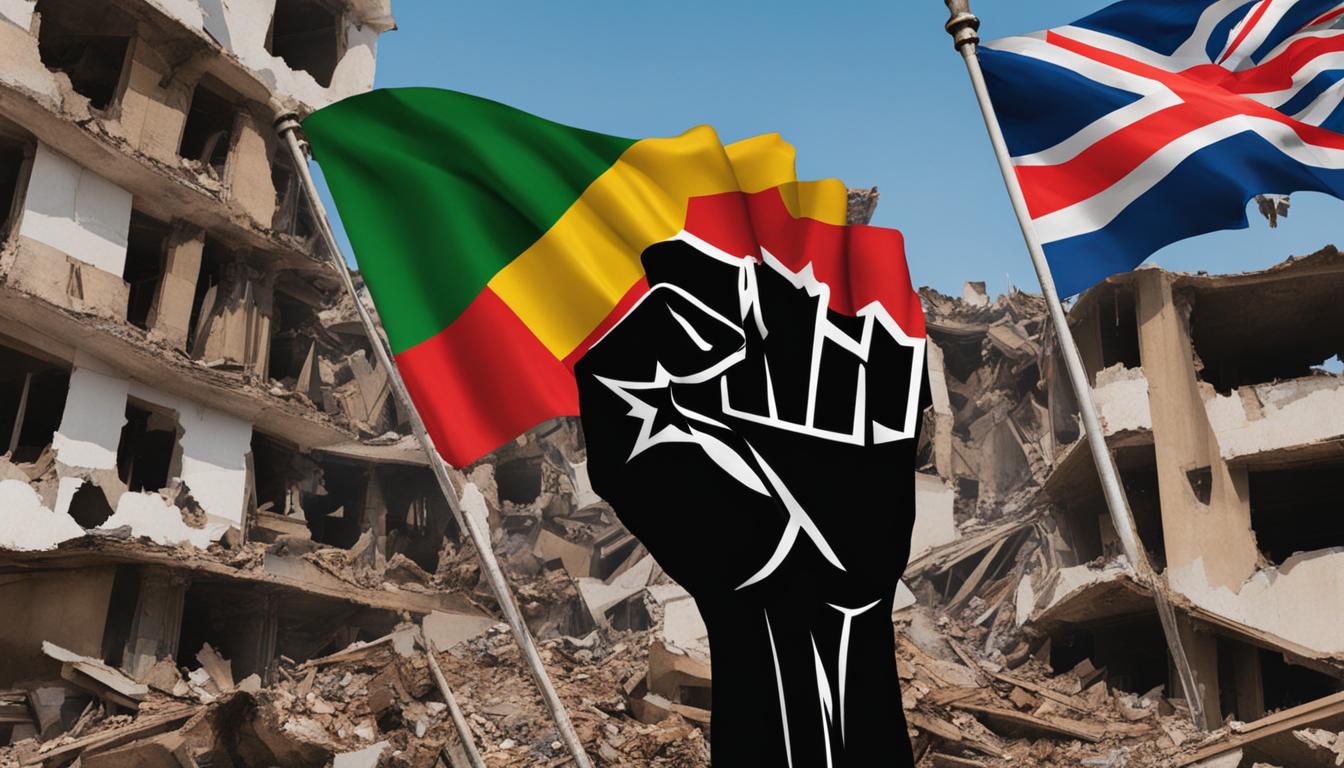
The end of the Derg regime in Ethiopia had a significant impact on subsequent African revolutions. Many movements across the continent drew inspiration from the Ethiopian experience, as they grappled with similar struggles against authoritarianism and pursued democratic transitions. Ethiopia’s defiance against an oppressive regime and its eventual triumph served as a powerful testament to the resilience and willpower of people advocating for change.
Analogy to Other African Movements
Examples of uprisings bearing striking resemblances to the Ethiopian struggle can be found throughout the African continent. Some noteworthy movements that were inspired by or paralleled the Ethiopian experience include:
- The Arab Spring in North Africa, which saw civil resistance against oppressive regimes in countries like Tunisia, Egypt, and Libya.
- Pro-democracy movements in West African countries such as Burkina Faso, where popular protests eventually led to the overthrow of long-time ruler Blaise Compaoré in 2014.
- The ousting of authoritarian leaders in Southern Africa, such as the end of Robert Mugabe’s 37-year rule in Zimbabwe in 2017.
These movements share common goals with the Ethiopian uprising against the Derg regime: the quest for liberation from oppressive governance and the pursuit of democratic transitions. By examining the parallels between these uprisings and the end of the Derg, one can glean important insights into the broader narrative of African resistance against authoritarian rule.
“Ethiopia’s defiance against an oppressive regime and its eventual triumph served as a powerful testament to the resilience and willpower of people advocating for change.”
Moreover, Ethiopia’s place in this collective memory also highlights the importance of fostering unity and solidarity among diverse groups engaged in the larger struggle for freedom, justice, and equality. The cross-border exchange of ideas and experiences not only supports individual movements but also enriches the pan-African narrative of resilience and determination that transcends geographical boundaries.
In conclusion, the influence of the Derg end on subsequent African revolutions is evident in both its direct inspiration and the underlying connective tissue binding each struggle for freedom. The shared pursuit of liberation from oppressive rule and democratic transitions unites diverse movements across the continent and embeds Ethiopia’s experience within the larger narrative of African resistance against authoritarianism.
Resilience and Growth: The Economic Impact Post-Derg Downfall
The economic landscape of Ethiopia post-Derg downfall is characterized by resilience and growth. The country has embarked on ambitious economic reforms aimed at improving living standards, attracting foreign investment, and diversifying the economy to mitigate the lingering effects of the Derg’s policies. In this section, we will explore some key areas that showcase the economic evolution and impact of post-Derg reforms on Ethiopia’s growth.
“Ethiopia has become one of Africa’s fastest-growing economies, with an average annual growth rate of around 9.8% from 2004 to 2019.” – World Bank
- Economic Growth and Development
- Foreign Direct Investment and Trade
- Agriculture: Modernizing the Backbone of Ethiopia’s Economy
- Industrialization: Expanding the Manufacturing Sector
- Investment in Infrastructure and Transportation
Economic Growth and Development
Post-Derg Ethiopia has experienced impressive economic growth as a result of strategic government policies and investments. Through fiscal prudence, the modernization of financial systems, and targeted investments in priority sectors, Ethiopia’s economy has grown steadily. The table below illustrates a summary of Ethiopia’s growth indicators.
| Indicator | Value |
|---|---|
| GDP Growth Rate (2004-2019) | 9.8 % (average) |
| Poverty Headcount Ratio at National Poverty Lines | 23.4 % (2019) |
| Human Development Index (HDI) | 0.485 (2020) |
Foreign Direct Investment and Trade
Post-Derg policies have focused on opening up the Ethiopian economy to attract foreign direct investment (FDI) and promote international trade. As a result, Ethiopia has made significant progress in attracting FDI, with sectors such as manufacturing, agro-processing, and infrastructure development being among the most attractive for foreign investors.
Agriculture: Modernizing the Backbone of Ethiopia’s Economy
For centuries, agriculture has been the mainstay of Ethiopia’s economy. Post-Derg policies have aimed at modernizing this sector to enhance productivity and support national food security. Through the provision of improved seed varieties, fertilizers, and extension services, agricultural productivity has notably improved.
Industrialization: Expanding the Manufacturing Sector
Post-Derg Ethiopia has pursued an industrialization policy, focusing on enhancing the manufacturing sector’s capacity to create jobs, raise export revenue, and stimulate growth. Industrial parks have been set up across the country to provide a conducive environment for manufacturing industries to thrive, attract foreign investment, and promote technology transfer.
Investment in Infrastructure and Transportation
Recognizing the crucial role of infrastructure in promoting economic development, post-Derg Ethiopia has made significant investments in infrastructure and transportation. The construction of mega projects, such as the Grand Ethiopian Renaissance Dam, the Addis Ababa-Djibouti railway, and numerous road networks, has improved connectivity and stimulated economic activity across the country.
In conclusion, the economic impact of post-Derg downfall in Ethiopia has been marked by resilience and growth. The Ethiopian government’s efforts to reform its economy have yielded improvements in living standards, attracted foreign investment, and laid the groundwork for a more diverse and thriving economic landscape.
Cultural Renaissance: Arts and Literature After the Derg Regime Collapse
Following the Derg regime collapse, Ethiopia experienced a cultural renaissance, with renewed interest in the arts and literature. The post-Derg era has seen an upsurge in creative expression and a reinvigoration of cultural identities, embodying the nation’s aspirations and reflecting on its historical narratives.

The Ethiopian arts scene flourished with various art forms, including contemporary painting, sculpture, photography, and traditional crafts. Galleries and cultural centers began to emerge across the country, creating spaces for artists to display their work, collaborate and contribute to the revived cultural legacy. This artistic revival not only fostered a sense of pride among Ethiopians but also attracted international attention, with Ethiopian artists gaining representation in prestigious global art events and exhibitions.
Post-Derg literature also witnessed a surge of new voices and narratives. Distinct literary styles emerged, reflecting the diverse cultural heritage of the country and revisiting both traditional and modern themes. Writers engaged in critical discussions on topics such as identity, history, and the socio-political dynamics of the nation, providing readers with thought-provoking insights and perspectives.
“The cultural renaissance of Ethiopia is not only about reviving the past but also about finding new ways to express ourselves creatively and imaginatively. It is about building bridges between our diverse communities and collectively sharing in the vast artistic wealth of our nation.”
Notable literary works from the post-Derg era include:
- Mengisteab Gebrekidan, for his progressive novels that uncover the intersections of the Ethiopian social fabric in a post-Derg context.
- Dinaw Mengestu, whose award-winning novels address themes of identity, immigration, and dislocation, exploring the experiences of the Ethiopian diaspora.
- Maaza Mengiste, a critically acclaimed author known for her historical fiction that delves into Ethiopia’s complex past, reflecting on the human consequences of war and upheaval.
Moreover, the cultural renaissance extended beyond visual arts and literature, manifesting in the revival of traditional music, dance, and theatre. Performances and showcases began to emphasize the diverse riches of Ethiopian culture and the creative exchanges between different ethnic groups.
To sum up, the cultural renaissance following the Derg regime collapse not only rekindled the nation’s creative spirit but also contributed significantly to the process of national healing and identity-building. The thriving Ethiopian arts and literature scene serves as a testament to the resilience, diversity, and unity of the Ethiopian people, who continue to construct a vibrant cultural legacy in the post-Derg era.
Unity and Diversity: Ethiopia’s Transformation Since the Derg Overthrow
Since the Derg overthrow, Ethiopia has undergone a significant transformation that emphasizes unity in diversity. Despite the rich mosaic of Ethiopia’s ethnic and cultural groups, efforts to maintain nationwide solidarity and integration continue to shape the country’s socio-political landscape in the post-Derg society.
Ethiopia’s transformation has been marked by various milestones, such as the implementation of a federal system that devolves power to regional states according to ethnicity, fostering a sense of inclusivity while encouraging inter-group collaboration. This approach promotes shared decision-making and represents a departure from the centralizing tendencies of the Derg regime.
Although maintaining unity amidst diversity can be challenging, Ethiopia’s journey showcases a resilient nation striving to harmonize the cultural, linguistic, and religious differences.
Furthermore, Ethiopia has made significant strides in facilitating a cross-cultural dialogue, educational reforms, and social development initiatives. Countless programs and projects aim to bridge the gaps between its various ethnic groups, nurturing a sense of national pride and solidarity despite Ethiopia’s colorful tapestry.
- Language and Education Reforms: Affirming the official status of local languages and diversifying the education system to reflect cultural perspectives.
- Media Representation: Ensuring that all ethnic groups have equal representation in local and national media outlets.
- Cultural Exchanges: Encouraging intercultural exchange through events, workshops, and collaborative artistic showcases.
| Aspect | Derg Era | Post-Derg Era |
|---|---|---|
| Politics | Centralized and authoritarian | Decentralized, federal system with regional autonomy |
| Governance | One-party rule, repression of opposition | Introduction of multi-party democracy, albeit with challenges |
| Education | Centralized system, restricted dissemination of local languages | Culturally sensitive, promotion of local languages and traditions |
| Culture | Suppression of cultural and religious expressions | Revival of cultural identities, fostering of national unity in diversity |
The journey towards unity and diversity has not been without its challenges, such as occasional ethnic tensions and political conflicts. However, Ethiopia’s relentless efforts demonstrate an unwavering commitment to establishing a harmonious, inclusive, and prosperous nation that respects and honors the diverse voices that make up its rich history.
Solidarity and Healing: The Derg Downfall Day in Contemporary Times
In contemporary Ethiopia, Derg Downfall Day is observed with an emphasis on solidarity and healing. Ethiopians come together to reflect on the nation’s turbulent past and reaffirm their commitment to mutual support and national reconciliation. It is a day for honoring the memory of the past and looking forward to a united future.
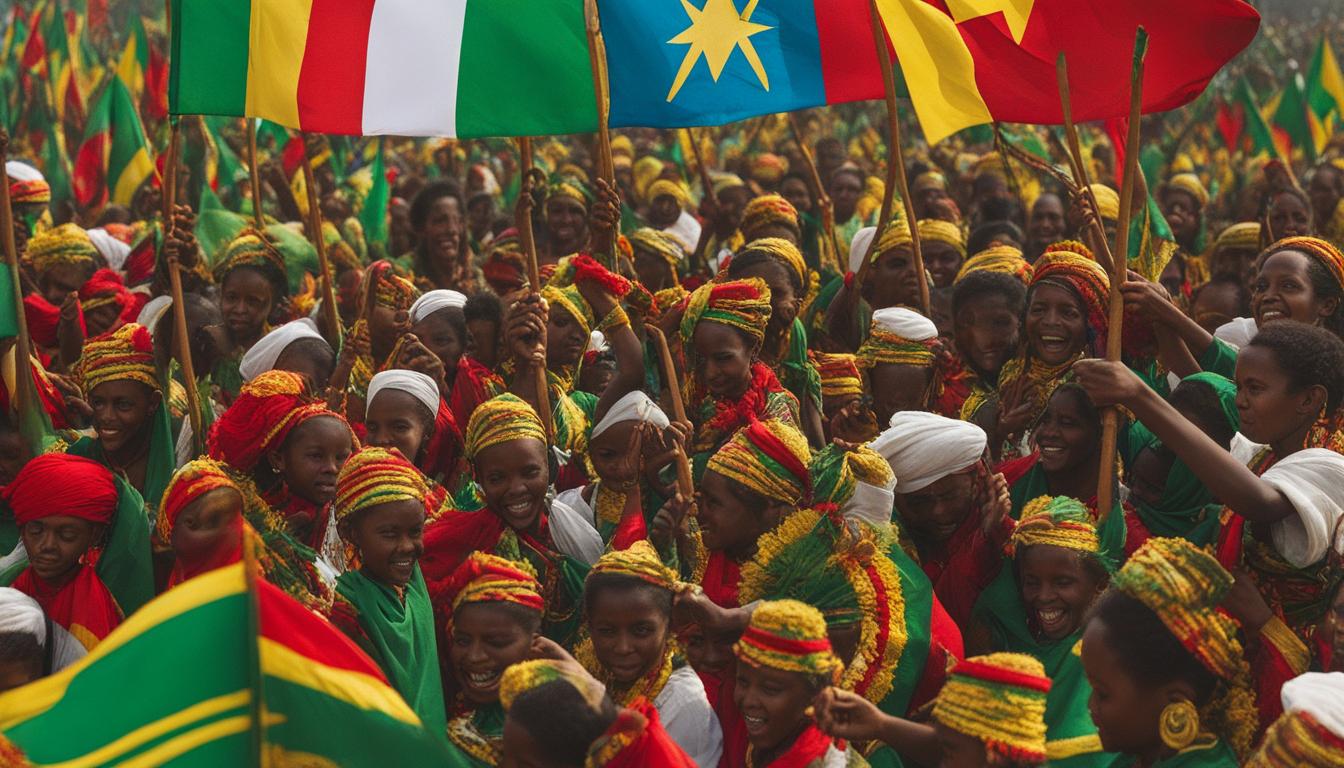
Various events are organized across the country, allowing citizens from all walks of life to participate in the commemoration. Some of these events include:
- Memorial services for the fallen heroes and martyrs of the civil war
- Art exhibitions featuring works inspired by the struggles and triumphs of the Ethiopian people
- Screenings of documentaries and films shedding light on the Derg regime and its consequences
- Cultural performances that celebrate Ethiopia’s rich and diverse heritage
“Derg Downfall Day is not just a reminder of our painful past, but also a testament to the indomitable spirit of the Ethiopian people. We must remember those who fought for freedom and continue their legacy by working towards a brighter, more inclusive future.”
One significant aspect of contemporary Derg Downfall Day celebrations is the focus on education and raising awareness among the younger generations about the importance of this historic milestone. Schools and educational institutions organize special programs and activities to engage students in understanding the history and significance of the Derg regime and its downfall.
| Educational Initiatives | Description |
|---|---|
| Interactive History Sessions | Students engage in discussions and debates about the Derg era and its impact on Ethiopian society |
| Storytelling and Art Workshops | Young people are encouraged to express themselves through creative mediums, sharing stories, poems, and artwork inspired by the themes of struggle and resilience |
| Guest Lectures and Panel Discussions | Academics and experts in the field of Ethiopian history and politics share their knowledge and insights with students |
| Field Trips to Memorials and Museums | Students explore the tangible history of the Derg era and the process of healing and reconciliation by visiting relevant sites and institutions |
As the memories of the Derg era continue to fade, it is vital to ensure that current and future generations understand the lessons of the past and appreciate the sacrifices made for the betterment of the nation. Derg Downfall Day provides an opportunity for Ethiopians to stand together in solidarity and healing, embracing a brighter and unified future.
Conclusion: Derg Downfall Day as a Reflection of Ethiopia’s Enduring Spirit
The commemoration of Derg Downfall Day serves as a powerful reflection of the enduring Ethiopian spirit and the nation’s continuous pursuit of progress and resilience. Recognizing this pivotal day in Ethiopian history allows the nation to look back on its triumphs and struggles and serves as a reminder of the importance of unity, reconciliation, and education for present and future generations.
As a national commemoration, Derg Downfall Day not only honors the sacrifices made during the Derg regime’s rule but also emphasizes the significance of the numerous changes Ethiopia has undergone since the regime’s overthrow. This day of reflection highlights the successful transition from a period of oppression to one of hope, democracy, and new beginnings.
By keeping the memory of Derg Downfall Day alive, Ethiopia remains committed to learning from its past and working towards a brighter, more inclusive, and prosperous future. The spirit of the Ethiopian people is ultimately what drives this transformation, symbolizing the unwavering determination required to forge a path forward while respecting and remembering the lessons of yesterday.
FAQ
What is Derg Downfall Day?
Derg Downfall Day marks an essential historic event symbolizing the end of the Derg regime’s reign in Ethiopia in 1991. This turning point in Ethiopian history represents a shift from oppressive rule to the promise of a new national direction. The celebration serves as a remembrance of those who sacrificed their lives in the civil war that led to the democratization and reform processes in the post-Derg era.
How did the Derg regime come into power?
The Derg, officially known as the Provisional Military Government of Socialist Ethiopia, came into power during the tumultuous period of the Ethiopian Civil War. It initially positioned itself as a regime that would rectify the wrongs of the past leadership but became known for its Marxist-Leninist leanings, oppressive tactics, and the enforcement of socialist policies that impacted the socio-political fabric of Ethiopia.
What led to the downfall of the Derg regime?
The fall of the Derg was the result of a sustained resistance movement and a series of battles that culminated in the collapse of the regime. The climactic moment arrived in 1991 when rebel forces entered the capital city, Addis Ababa, leading to the surrender of the Derg leadership and a major realignment of the nation’s governance structure.
What is the significance of the Derg Downfall for Ethiopia?
The significance of the Derg Downfall lies in the hopeful inception of a new beginning for Ethiopia. It promised a break from the past’s restrictive policies and aimed at embarking on a path of reform and democratization that would craft a resilient, inclusive, and prosperous nation.
How did the aftermath of the Derg downfall impact Ethiopian society?
The aftermath of the Derg downfall saw significant political and social changes as Ethiopia transitioned towards a federal system aiming for greater regional autonomy and democratic governance. This period also marked the beginning of rebuilding initiatives in various spheres of social development, such as education, healthcare, and infrastructure.
How do Ethiopians commemorate Derg Downfall Day?
National celebrations on Derg Downfall Day encompass a variety of events including patriotic speeches, parades, and cultural performances. These festivities serve both as a remembrance of the hardships of the past and celebration of the hope and unity that the downfall bestowed upon the nation.
How has education evolved in Ethiopia following the Derg downfall?
Curriculum development post-Derg focuses on teaching future generations about Ethiopia’s complex history, including the period of the Derg regime’s rule, its impact on Ethiopian society, and the struggle that led to its downfall, ensuring that the lessons of the past are passed on to uphold the values of democracy and national unity.
How has Ethiopia’s economic landscape changed after the Derg downfall?
The economic landscape of Ethiopia post-Derg downfall is characterized by resilience and growth. The country has embarked on ambitious economic reforms aimed at improving living standards, attracting foreign investment, and diversifying the economy to mitigate the lingering effects of the Derg’s policies.
What is the role of women in the fall of the Derg regime?
Women played a significant role in the fall of the Derg regime, both on the frontlines and behind the scenes. Their involvement ranged from participation in battles to providing essential support roles, breaking traditional gender stereotypes and paving the way for women’s empowerment in the socio-political realm.


